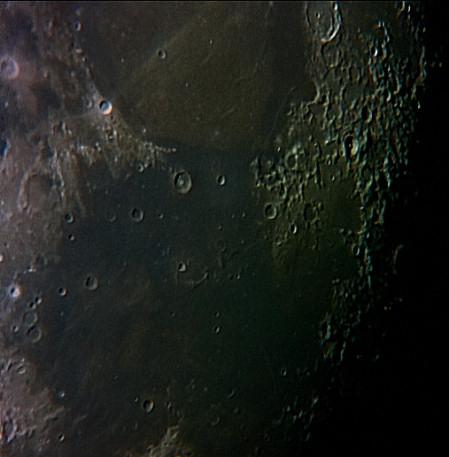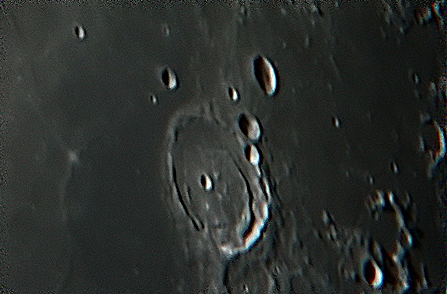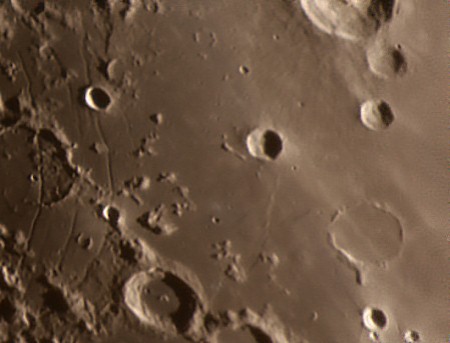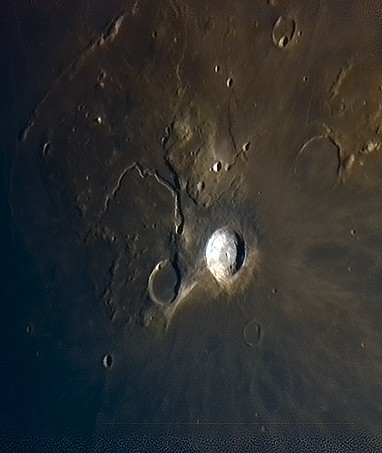Near Bullialdus crater (at top-right side of the picture) there is a quite interesting region called Rimae Hippalus. Hippalus crater is the big one (left-center side of the picture). It is a big crater. In this image, shadows in this crater due to a low altitude sunlight creates a visual effect, as if a great creature had stamped his bare footprint in lunar soil. Do you see it?
Archive for Manual-Crazy-Tracking
Moon scratched by the claw of a bear
Posted in Astrophotography with tags Astronomy, Astrophotography, Bullialdus crater, Canon EOS 450D, Manual-Crazy-Tracking, Meade Lightbridge 16", Moon, Newtonian, no tracking, Reflex, Registax, Rimae Hippalus, Telescope on 2011/08/31 by computerphysicslabAristarchus crater (Moon) with Meade Lightbridge 16 inch
Posted in Astrophotography with tags Astronomy, Astrophotography, Canon EOS 450D, crater, Manual-Crazy-Tracking, Meade Lightbridge 16", Moon, Newtonian on 2011/04/17 by computerphysicslabAristarchus crater (Moon) with Meade Lightbridge 16 inch:
Aristarchus is a large impact crater on the Moon, is in the northwest of the nearside of the Moon. It is considered the brightest of the large formations on the lunar surface, its albedo is nearly double that of most other geographical spots. The crater is bright enough to be visible to the naked eye and is stunning when viewed through a large telescope. It is also easy to identify when most of the lunar surface is illuminated by reflection of light on Earth.
The crater is located on the southeast edge of the Aristarchus Plateau, an area that contains several high volcanic features, such as wrinkling rimes. This area is known for it have been detected in a significant number of transient lunar phenomena of nature as well as by recent emissions gas radon to be measured by the spacecraft Lunar Prospector.
Mare Tranquillitatis in color
Posted in Astrophotography with tags 150/750, afocal, Astronomy, Canon EOS 450D, Manual-Crazy-Tracking, Mare Serenitatis, Mare Tranquillitatis, Moon, Newtonian, Paint Shop Pro, Rebel XTi, Reflector, Registax, Telescope, terminator on 2009/09/11 by computerphysicslabColor contrasts in the Moon are interesting even beautiful. The following picture shows Mare Tranquillitatis area and the southern part of Mare Serenitatis in full color. It was taken 4 days after full moon. The shadows in the terminator show the orography of the landscape. Mare Tranquillitatis seems to be mainly blue. This is due to its peculiar chemical composition.

Pitiscus
Posted in Astrophotography with tags 150/750, afocal, Astronomy, Canon EOS 450D, crater, Hommel, Ideler, Manual-Crazy-Tracking, Moon, Newtonian, Noiseware, Paint Shop Pro, Pitiscus, Rebel XTi, Reflector, Reflex, Registax, Spallanzani, Telescope, terminator on 2009/09/09 by computerphysicslabPitiscus, Hommel, Ideler and Spallanzani are the only four craters of the picture with proper name. The rest of them are named by letter surnames like Ideler R or Ideler L. They are located in the South-East area of the Moon. The picture was taken on 2009-09-09 05h 20m U.T. and the terminator was passing across Pitiscus, Hommel, the two big and shadowed craters. Pitiscus is 85 km wide and Hommel is 129 km (76 miles). The smallest craters of the image are 7 km wide, that is 3.5 arcseconds, 1.75 arcseconds for the bright spot and 1.75 arcseconds for the shadow spot. Image detail could then be better for a 6-inch telescope (this is the equipment used to take the image, an scope capable up to 0.7 arcseconds of resolution). 622 subframes were recorded with the Manual-Crazy-Tracking system and stacked in Registax 5.

Posidonius
Posted in Astrophotography with tags 150/750, afocal, Astronomy, Canon EOS 450D, Chacornac, crater, Manual-Crazy-Tracking, Mare Serenitatis, Moon, Newtonian, Noiseware, Posidonius, Rebel XTi, Telescope on 2009/09/08 by computerphysicslabPosidonius is a big crater of the Moon on Mare Serenitatis. There is a lot of interesting details to observe inside: peaks, ridges, craterlets, … In the following image taken yesterday night, 4 km wide craters can be spot as small white points in the smooth surface of Mare Serenitatis.
Posidonius measures 95 km in diameter. The second biggest crater (a bit ghostly) in the picture is Chacornac, just below Posidonius. Inside it is visible a small craterlet called Chacornac A (it measures 5 km in diameter).
The third biggest crater of the picture is Daniell (31 km wide) located in the upper middle side. Its shape is not circular, but oval. This is the cause of a strange effect in perspective when comparing it with the craters nearby.

PosidoniusPosidonius is a lunar impact crater that is located on the western edge of Mare Serenitatis
Dorsum Oppel
Posted in Astrophotography with tags 150/750, afocal, Astronomy, Canon EOS 450D, Dorsum Oppel, Manual-Crazy-Tracking, Mare Crisium, Moon, Newtonian, Peirce, Proclus, Swift, Telescope, terminator, wrinkle ridge, Yerkes on 2009/09/07 by computerphysicslabDorsum Oppel is a wrinkle ridge of the Moon in Mare Crisium. 2 days after full moon is the best moment to observe it. It is a very large formation and the landscape along is quite impressive, full of small craters, tiny mountains and the smooth floor of Mare Crisium. It is important to reach a high magnification to enjoy the view (150x at least).
My setup is a 6-inch telescope, but I bet it is possible to observe it comfortably with a 4-inch refractor.

The bright and overexposed crater is Proclus. I have to work harder the dynamic range issue next time.
Swift and Peirce are the pair of craters in the upper side of the picture, near the lunar terminator. Below Peirce should be visible a 2 kms wide craterlet, but unfortunately my picture cannot yield such a resolution. According to a quick calculation, 3 kms is the smallest visible feature in theis image, and that corresponds to 1.5 arcseconds. A bit far still to the maximum theoretical resolution of a 6-inch telescope (that is around 0.7 arcseconds)
Yerkes is the big ghostly crater in the right side. Apparently there is a central peak in its center. I have been looking for a confirmation of the existence of that peak, but I haven’t found any reliable source where it is mentioned. Any hint here, I would be thankful…
Manual Crazy Tracking
Posted in Astrophotography with tags 150/750, afocal, Astronomy, GRS, Jupiter, Manual-Crazy-Tracking, Newtonian, shift-and-add, Telescope, webcam on 2009/09/01 by computerphysicslabLacking of an equatorial mount I have built myself a kind of manual tracking system that keeps into the field of view of a webcam a planet like Jupiter, for 3 minutes. This is long enough to record useful data and then post-process it with aggressive wavelets.
The resulting tracking is not at all perfect. You may see Jupiter swinging around the screen. It is important to capture the data at a fast shutter speed (1/100 sec.) to avoid motion blur in every frame because the planet is always dancing.
In spite of this movement, the results after stacking are very good. Here I show this really simple system and the resulting yesterday’s Jupiter with the webcam:
![]()
![]()
![]()
As you can see the Manual-Crazy-Tracking is a very simple system that consists in a rubber band attached to the tripod handle. If you try to track manually directly pushing the tripod handle, the shaking is excessive and you would need a very very fast shutter speed to get some useful data. The rubber band is necessary to reduce vibrations and increase the shift movement control.
At beginning Jupiter is located in the center of the field of view with no need to any corrections. As long as it drifts due to its sidereal movement you will have to pull using the rubber band in order to keep it in the center of the screen (it is supposed you have a laptop there capturing and showing images from the webcam). This way you may have Jupiter centered in the screen for a long time. You will have time to focus (left hand pulling the rubber band and right hand tweaking the focuser) and time to expose.

